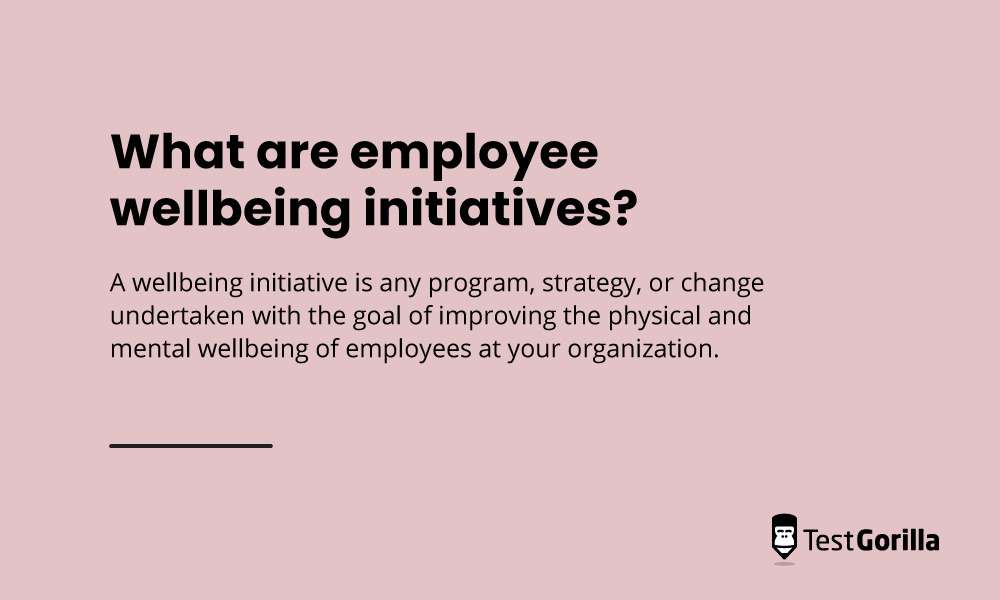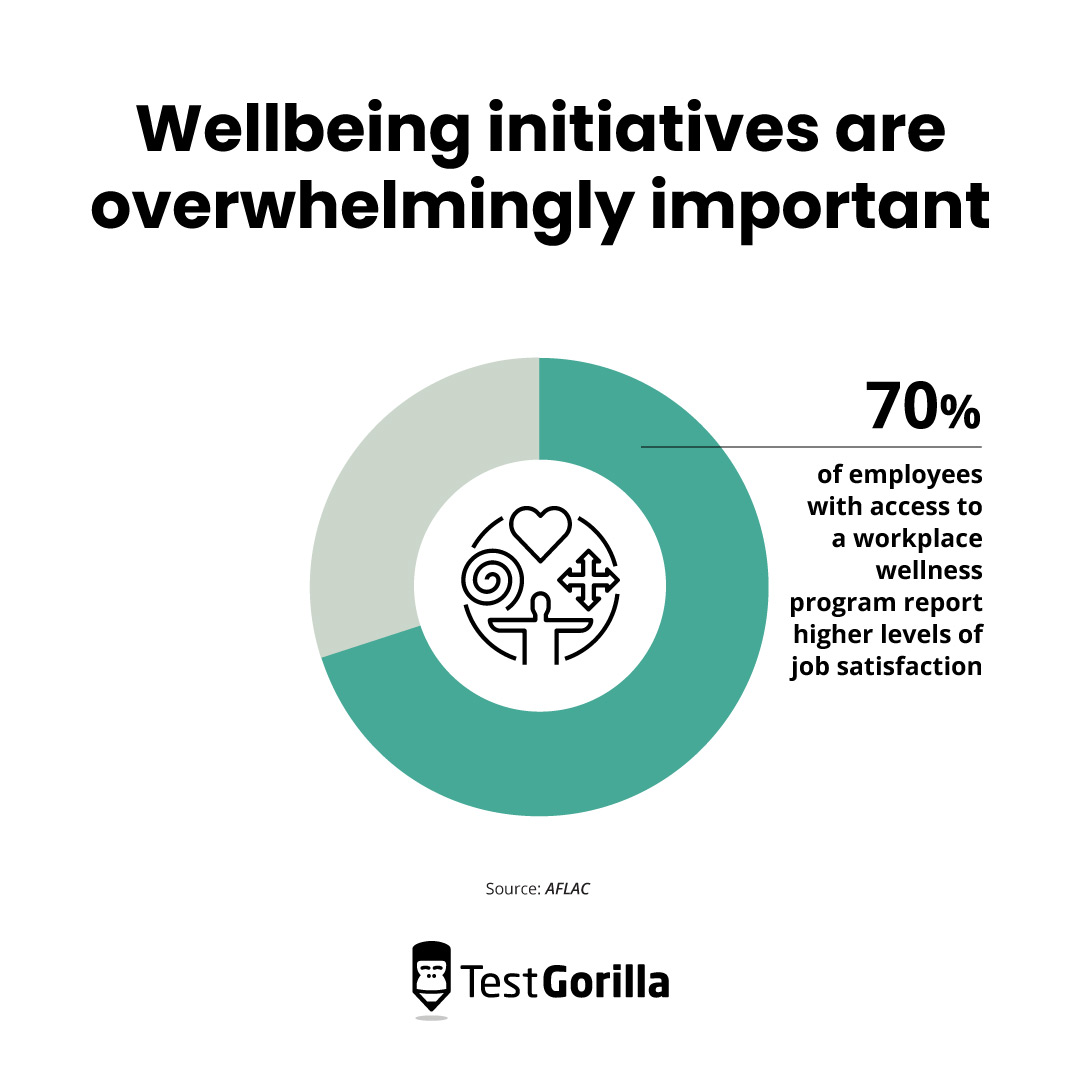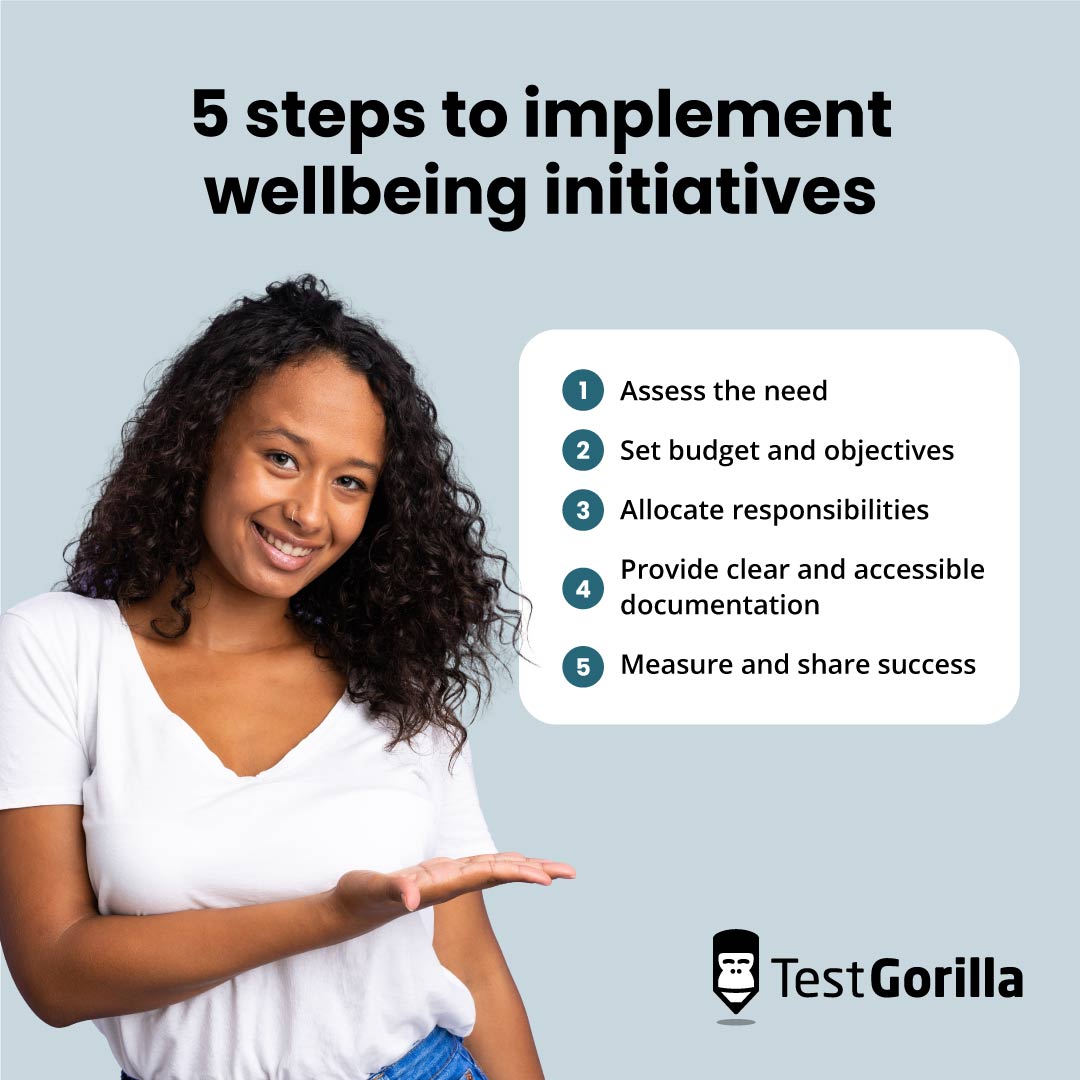As the world of work continues to evolve, employees are looking for more than a steady paycheck.
A positive work environment, flexible hours, and a handful of employee wellbeing initiatives are three desires that top job hunters’ lists today.
To compete for new talent, retain existing employees, and add to your workplace culture, you need to rethink how you run wellbeing programs.
The critical first step is understanding what’s feasible and how to implement it.
In this guide, we show you how to achieve both goals, explain 13 popular wellbeing initiatives, and provide a step-by-step guide to implementation so you can get started right away.
Table of contents
What are employee wellbeing initiatives?
A wellbeing initiative is any program, strategy, or change undertaken with the goal of improving the physical and mental wellbeing of employees at your organization.
Many initiatives look to target wellbeing in a direct way, such as a company fun run to improve physical health or paid counseling support for mental health. But a holistic employee wellbeing strategy can (and should) be much broader than this.
Changes to office design, like improving air quality, adding more quality daylight, and even offering healthy snacks, can improve employee wellbeing.
The overwhelming importance of wellbeing initiatives
The statistics on employee wellbeing are startling:
87% of employees consider health and wellness offerings as part of their job-hunt criteria [1]
70% of employees with access to a workplace wellness program report higher levels of job satisfaction
Only half of all companies offer at least one employee wellness initiative[2]
In short, nearly all job hunters find wellbeing initiatives to be important enough to consider in conjunction with factors like pay and location. Most employees report higher levels of job satisfaction when they work at a company offering these initiatives.
But a full half of companies don’t even offer one wellness initiative.
Clearly, there is a disconnect between what employees want and what employers are offering.
It’s a bad thing for employees, to be sure, but it’s an important opportunity for companies like yours to outcompete other recruiters by designing and offering a set of employee wellbeing initiatives that cater directly to this desire.
In the next section, we’ll discuss 13 examples of initiatives you can leverage to take advantage of this opportunity.
13 employee wellbeing initiative examples
Before designing your wellbeing initiatives, you need to understand what constitutes wellbeing in the workplace.
Let’s start by exploring the seven areas of wellbeing.
The seven key areas of employee wellbeing
The Chartered Institute of Personnel and Development outlines seven key areas of employee wellbeing.
Area of employee wellbeing | Examples |
1. Health | Access to medical care Physical safety in the work environment Comfortable working conditions, e.g. ergonomic chairs |
2. Good work | Employees understand the value of their work They have control over what work they do Fair compensation |
3. Values | Visionary leadership High ethical standards Inclusive company culture |
4. Social life | Cohesive, healthy work culture Regular opportunities to socialize |
5. Personal growth | Professional development Strong internal promotion and advancement |
6. Good lifestyle choices | Healthy eating Regular exercise |
7. Financial wellbeing | Fair compensation and benefits Retirement planning Financial assistance |
If you support employees in the seven areas we outlined above, you’re likely to see increases in:
Productivity at work
Resilience when faced with challenges
Quality of work
Employee engagement
In fact, wellness programs have been shown to reduce absenteeism by 14%-19%.
All of this has big implications for your bottom line.
A Glassdoor study found that each one-star improvement in an organization’s rating by employees corresponds to a 1.3-point improvement in customer satisfaction scores.
The 13 examples of employee health wellbeing initiatives we’re about to share are designed to cover each of the seven areas discussed above – and some of them even cover more than one.
Employee wellbeing programs cheat sheet
Wellbeing area | Initiatives |
Health initiatives | 1. Mental health resources 2. Ergonomic office equipment 3. Wellness challenges 4. Office design improvements |
Social initiatives | 5. Employer-funded social club 6. Virtual hangouts for remote teams 7. Support for coworking spaces for global teams |
Financial initiatives | 8. Support for financial planning 9. Work-related spending reimbursement |
Personal development initiatives | 10. Access to mentorship 11. Professional development planning |
Work-life balance initiatives
| 12. Flexible schedules 13. Outcome-based work |
Health initiatives
A Stanford study found that roughly 8% of national healthcare outlays are due to employee burnout, coming to a total of $190bn and nearly 120,000 deaths each year.
By implementing any of these health-focused wellbeing initiatives, you can be a part of the change that brings this number down.
1. Mental health resources
Providing support for employee mental health is crucial for improving happiness, job satisfaction, and overall wellbeing.
Access to counseling and psychological support is a good start here. You may choose to do this through a wellness reimbursement plan or by setting up your organization with a corporate counseling program.
Mental health is about more than counseling, however, so consider providing access to resources related to:
Mindfulness
Relaxation and stress management/reduction techniques
The relationship between physical and mental health
2. Ergonomic office equipment
For many employees, work means sitting down at a desk for eight hours a day.
We know this is not conducive to a healthy core or spine, potentially leading to health issues, but employers can reduce rates of injury and discomfort by investing in health-focused office equipment like:
Ergonomic office chairs
Standing desks
Footrests
Ergonomic keyboard and mouse
Lower back and lumbar support
If you’re operating remotely, then providing employees with a home-office allowance would give them an opportunity to invest in ergonomic equipment to keep their home workspace healthy.
3. Wellness challenges
Wellness challenges are a fantastic one-off initiative with the dual effect of prompting physical health and wellbeing while creating a bit of team building and bonding.
Examples of wellness challenges include:
A company 5k or fun run
One month membership to hot yoga + a competition to see who attends the most classes
A competition formatted like “The Biggest Loser”
A challenge to take 10,000 steps a day
Sober October
Hydration challenge (who can drink the most water each day)
4. Office design improvements
Here’s an interesting tidbit: Air and water quality and decent lighting are the most important aspects of on-site office comfort for workers.[3]
So, if you want to make the biggest impact possible, invest in some office updates, such as:
Installing new air purification systems and air conditioning (and open some windows if possible)
Maximizing daylight or investing in naturalist lighting (not too dark, not too light)
Providing fresh, clean water (a good water cooler is a simple and cost-effective initiative)
Social initiatives
Workplace wellbeing initiatives should go beyond looking only at physical and mental health.
Work is, after all, a social space where people are interacting with each other daily.
Although the world of remote work has undoubtedly had a major impact on what those interactions look like, a thought-out social wellbeing initiative can regain that lost ground and go a long way to developing a cohesive and positive company culture.
5. Employer-funded social club
Speaking of good company culture, social clubs are another great way to build camaraderie among coworkers.
In many cases, social clubs are self-funded, but a little employer-funding can go a long way.
For example, if someone in your employment wishes to head up a social club, volunteer to match employee contributions dollar for dollar. That way, members can plan outings more regularly and build rapport without the ties of a “work-sanctioned event.”
6. Virtual hangouts for remote teams
Work-from-home depression is a real thing, and remote teams need a bit of social time, too.
Employers often underestimate the value of the small interactions that happen in in-person offices – at the water cooler, in hallways, during lunch breaks, and while grabbing a coffee – that remote employees don’t have an opportunity to access.
By scheduling a virtual social hangout (during work hours so everyone can attend) is a great way to bring a little bit of human interaction back into the mix.
7. Support for coworking spaces for global teams
Another great way to support remote and hybrid workers is to provide an allowance for coworking memberships.
That’s right, working from home doesn’t have to mean working from home.
Even agreeing to pay for half of a coworking membership for willing employees goes a long way, and it can provide your remote workers with an opportunity to meet new people in a similar situation.
And who knows? They might even learn something valuable from someone in a similar role at a different organization and apply that knowledge to their own work.
Financial initiatives
At the end of the day, we all come to work to make money.
It may not be the only reason we work, but it’s a significant one for many. However, it's not just about the money itself – it's the opportunity that money buys us.
What employees earn at work is used to pay off student loans, invest for retirement, and save for vacations and family getaways.
Wellbeing initiatives can also reach into the financial realm to help employees get more value from their earnings, providing more opportunity from each dollar they earn.
8. Support for financial planning
One of the most valuable ways you can help employees get the most out of their paycheck is by providing support for financial planning services.
It's best to contract an external supplier here to prevent any conflicts of interest.
Some examples of great initiatives include:
Student loan repayment advice
Retirement planning
Speaking of retirement planning, you can go a lot further than simply offering a 401(k) plan.
Consider, for example, the Save More Tomorrow intervention, which uses behavioral economics to increase employee savings.[4]
The idea is simple. We’re much more willing to commit future money to savings than current money. So, Save More Tomorrow has employees commit (at their own volition) to increasing their retirement savings percentage each time they get a pay raise.
9. Work-related spending initiatives
Most organizations have some form of system for reimbursing work-related spending (for example, if someone pays for their work phone’s screen protector and wishes to be reimbursed).
Unfortunately, these are often slow and cumbersome and leave employees paying out of pocket for longer than necessary.
Initiatives that can support financial wellbeing by minimizing these issues include:
A digital reimbursement and claims platform
Employee spending cards
Preferred suppliers from whom employees can purchase and charge expenses directly to the company
Personal development initiatives
Personal development is an important psychological driver, especially in the workplace.
When people feel like they’re moving toward a goal, they experience an increase in positive emotions and feel a greater sense of purpose and meaning.
If their daily work can help them achieve such senses, you can improve their quality of life and prevent employee turnover.
10. Professional development planning
Professional development is a real win-win.
By offering career guidance and building individualized step-by-step plans for employee development, you:
Build more agency into their work life, enhancing overall job satisfaction
Create more engaged and motivated employees
Grow your internal skill set without the need to recruit
11. Access to mentorship
Mentorship often gets mixed up with professional development, or simply leadership and management.
Although it's true that your boss can (and, to some extent, should) be a mentor, having an external mentor who sits out of the business is often a more helpful arrangement.
That’s because employees can discuss a wider variety of topics and gain an objective outside perspective, bringing up issues such as:
Work relationship challenges
Career planning in a wider (non-company) context
How to approach difficult conversations – for example, asking for a raise
Work-life balance initiatives
There’s a lot that can be done to improve employee wellbeing at work.
But remember, someone who works 40 hours a week only spends 24% of their weekly hours at work.
Work-life balance initiatives are a powerful way to give employees more power and autonomy to improve their overall health while improving their sense of agency, purpose, and work satisfaction.
12. Flexible schedules
Giving your employees the ability to control their own schedules is a fantastic way to enhance work-life balance.
Let’s be realistic.
Does your entire team need to be at work from 9 a.m. to 5 p.m.?
For some customer-facing roles, the answer might be yes because you need to cater to opening hours.
But for many office workers and remote employees, the 9-to-5 work schedule is a little outdated. If it works better for one of your employees to knock out a chunk of work from 7-9 p.m. to give themselves an extended afternoon break, how much does that impact their success?
That said, there is a case for employees being online at the same time for ease of communication and meeting scheduling.
A good workaround here is to have a “mandatory online” window, such as 10 a.m. to 2 p.m. Here, employees have a four-hour window where they need to be available for team comms, Slacks, emails, and meetings. The other four hours a day is up to them to manage.
13. Outcome-based work
Since you’re rethinking the 9-to-5 schedule, why not go a step further and ask whether a 40-hour work week is even necessary?
In some organizations, it may be more appropriate to switch to an outcome-based work schedule. Here, employees are given clear expectations as to output, which should amount to around 40 hours a week (for full-time employees) in most cases.
Employees are then given the freedom to complete these tasks when they want and on their own time.
That means they can work weekends if they want or pull a 12-hour day to give them four hours free the next day. It does mean that, in some cases, hours vary from week to week.
Employees (and managers) need to be comfortable with the idea that while some weeks might only add up to 35 hours, others might require more than 45. The important thing is that the average of the total amount of work done equals what would otherwise be completed in a standard 40-hour week.
Guidance for implementing employee wellbeing initiatives
You’ve got a good idea now of what kind of employee wellbeing ideas might be suitable for your employees.
Now it's time to put a plan in place and actually get those initiatives rolling.
The following is a brief five-step guide on how to implement wellbeing initiatives and make sure they have the positive impact you’re aiming for.
1. Assess the need
Before you invest a dollar in any of the above strategies, it's a smart idea to make sure that any initiatives you have in mind actually connect with the people they’re designed to benefit.
An employee survey is a good tool here.
Keep it as short as possible to maximize engagement, using questions like:
What do you feel like your wellbeing benefits package is missing?
If you were to implement one wellbeing initiative in the workplace, what would it be?
What’s more important to you: health-related benefits or work-life balance?
On a scale of 1-10, how important is “X initiative” to you?
2. Set budget and objectives
Now that you know what your employees value (and how that stacks up with the initiatives you had in mind), you can begin building a plan.
There are two clear tasks to complete at this stage.
Your first is to establish a budget for employee wellbeing solutions. A good idea is to come up with a per-employee budget.
Begin with what you’re able to invest in right now on a yearly basis. Let’s say it's $100,000 a year. Divide that by the number of employees you have. If you have 100 employees, then your annual budget is $1,000 per employee.
The reason for breaking it down by employee is that as your company grows, the wellbeing budget increases appropriately, so per-employee allocations don’t decrease over time.
Your second step is to define clear targets for what you want to achieve with the programs you choose.
For instance, if you choose to implement flexible work hours, you might do so with the idea of improving self-reported satisfaction with a better life work balance.
You then need to measure that satisfaction rate, set a target number, and put a plan in place for retesting after the initiative has been in place for a sufficient period of time (i.e., 12 months in many cases).
3. Allocate responsibilities
You didn’t think you were doing this on your own, did you?
Now is the point where you pull together your team and allocate responsibilities for rolling out each wellbeing initiative.
You need people in charge of:
Scouting suppliers
Communicating benefits to team members
Organizing schedules for events
Orchestrating initiatives, like creating the process for developing professional development plans
In many cases, this requires people from multiple departments to work closely together. For example, in the case of support for financial planning, you might involve stakeholders from finance, human resources, and company leadership.
Your job here is to draw up the specific responsibilities and tasks required of each party. A task management platform like Trello might be a good move here to keep everyone organized and to ease communication.
4. Provide clear and accessible documentation
Here’s something that’s likely a little surprising.
Although many companies offer programs for physical, mental, and financial wellbeing, rates of usage by employees are another thing entirely.
Just look at those last two bars: 87% of companies offer mental wellbeing support, but only 23% of employees take advantage of them.
One thing you can do to reverse this trend is to ensure that communication on the company’s part is on point by:
Creating a document hub where all employees access information about initiatives and how to use them
Putting someone in charge of regular communication about available employee benefits
Ensuring that education about the wellbeing initiatives your company offers is included as part of the new employee orientation and onboarding process
Finally, it's a good practice to create an open line of communication for feedback and suggestions. An anonymous online form is a good move here because it ensures that those who feel uncomfortable about speaking up still have a chance to voice any concerns or ideas.
5. Measure and share success
Finally, before you hit the green button and launch your first wellness initiative, make sure you have a plan for measuring success.
Set key performance indicators (KPIs) up front, and then define your measurement tool.
In most cases, these will be employee surveys similar to the ones you ran in point one, except focused on the impact of the new initiatives. You might also include a question or two that asks for improvement suggestions.
Your objectives from point two should be your guiding star here, though participation rates should be an important part of your measurement plan.
Track usage across all benefits, and then focus your communication specifically on those underutilized services.
Don’t be afraid to reallocate spending, however, if a particular benefit goes unused.
For example, if nobody accesses your mentorship initiative, it may be worth replacing this with more spending in an area that has attracted more interest, such as physical health initiatives.
You can always leave the door open to revisit that service, especially if you’ve implemented the feedback form we discussed earlier.
Health-based initiatives are only one part of the employee wellbeing picture
Improving employee wellbeing is an important endeavor for maximizing engagement and work satisfaction and for helping workers find meaning in their employment.
Physical and mental health-based initiatives are an important part of the puzzle, but they are only one piece.
Professional development, financial wellbeing support, and work-life balance initiatives should all be taken into consideration when designing a wellbeing offering.
Consider the fact that not everyone is motivated by the same initiatives and rewards, so before you create your offering, be sure to find out what motivates your employees. We also recommend you use a Motivation test when hiring to measure whether candidates’ expectations align with the job offer and your organizational culture
Sources
Peterson, Amy. (June 3, 2013). “Employees Place a Premium on Culture of Wellness but Employers Still Struggle to Communicate and Measure the Effectiveness of Programs, According to New Virgin HealthMiles Survey”. Business Wire. Retrieved October 25, 2023. https://www.businesswire.com/news/home/20130603005303/en/Employees-Place-a-Premium-on-Culture-of-Wellness-but-Employers-Still-Struggle-to-Communicate-and-Measure-the-Effectiveness-of-Programs-According-to-New-Virgin-HealthMiles-Survey
“Making Workplace Health Promotion (Wellness) Programs ‘Work’”. (February 11, 2015). Institute for Health and Productivity Studies. Retrieved October 25, 2023. https://publichealth.jhu.edu/institute-for-health-and-productivity-studies/2015/making-workplace-health-promotion-wellness-programs-work
Meister, Jeanne. (August 26, 2019). “Survey: What Employees Want Most from Their Workspaces”. Harvard Business Review. Retrieved October 25, 2023. https://hbr.org/2019/08/survey-what-employees-want-most-from-their-workspaces
Thaler, Richard; Benartzi, Shlomo. (2004). “Save More TomorrowTM: Using Behavioral Economics to Increase Employee Saving”. Journal of Political Economy. Retrieved October 25, 2023. https://www.jstor.org/stable/10.1086/380085
Related posts
Hire the best candidates with TestGorilla
Create pre-employment assessments in minutes to screen candidates, save time, and hire the best talent.
Latest posts
The best advice in pre-employment testing, in your inbox.
No spam. Unsubscribe at any time.

Hire the best. No bias. No stress.
Our screening tests identify the best candidates and make your hiring decisions faster, easier, and bias-free.
Free resources
This checklist covers key features you should look for when choosing a skills testing platform
This resource will help you develop an onboarding checklist for new hires.
How to assess your candidates' attention to detail.
Learn how to get human resources certified through HRCI or SHRM.
Learn how you can improve the level of talent at your company.
Learn how CapitalT reduced hiring bias with online skills assessments.
Learn how to make the resume process more efficient and more effective.
Improve your hiring strategy with these 7 critical recruitment metrics.
Learn how Sukhi decreased time spent reviewing resumes by 83%!
Hire more efficiently with these hacks that 99% of recruiters aren't using.
Make a business case for diversity and inclusion initiatives with this data.
























